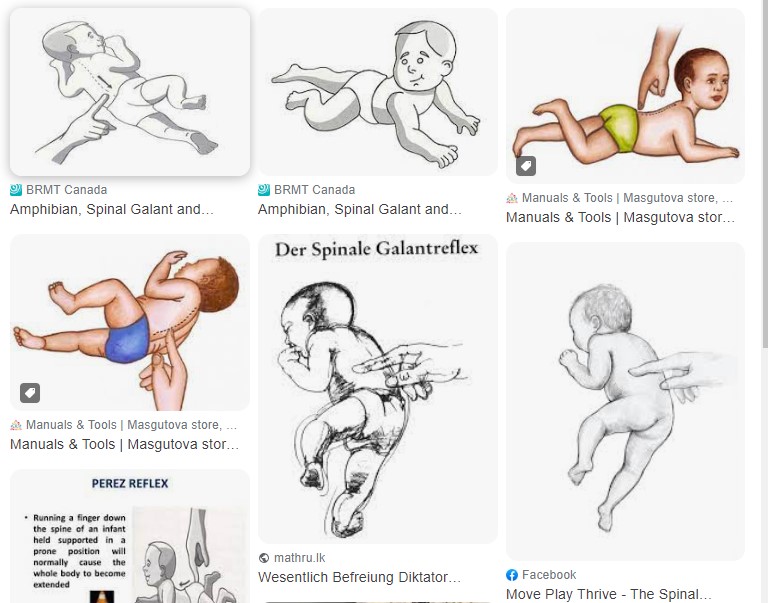Spinal Galant reflex: Have your toddler lie on her again and flow her limbs in a “snow angel” shape, until her palms meet on the precise of her head and her feet come together. Do that five times in a row, at least two times a day, till the Spinal Galant reflex can now not be elicited with the aid of stroking the low back. The Spinal Galant Reflex This reflex factors toddlers to twist their hip outward if the decrease again is stroked next to the spine. Its objective is to encourage movement and grow wide variety of motion in the hip in coaching for jogging and crawling.

How do you combine the palmar reflex?
Palmar Reflex: Have baby squeeze a small ball, together with a stressball, quite a few instances in a row. Or you could simply stroke the palm of the hand with a lightweight brush until the reflex is suppressed. 4. ATNR: Ask the kid to get in crawling place with palms pointing ahead and the top in neutral.
What is Spinal Galant reflex?
Galant reflex, or truncal incurvation reflex, is a new child reflex, named after neurologist Johann Susmann Galant. It is elicited with the aid of protecting the newborn in ventral suspension (face down) and stroking along the single part of the spine. This is probably the reflexes demonstrated in newborns to assist rule out brain damage at birth.
Also read : How do you find vertical distance?
What happens if Moro reflex doesn’t move away?
Your baby’s startle reflexes will start to disappear as they grow. By the point your infant is three to six months old, they might be will not reveal the Moro reflex any longer. They’ll have extra handle over their movements, and their reflexes will come to be less jerky.
Can you test your individual reflexes?
To experiment your reflexes, your medical professional will use a rubber hammer to faucet firmly at the tendon. If certain reflexes are reduced or absent, it’s going to exhibit what nerve maybe compressed. Not all nerve roots have a reflex associated with them.
What are the 5 primitive reflexes?
Contents Adaptive magnitude of reflexes. Sucking reflex. Rooting reflex. Moro reflex. Walking/stepping reflex. Asymmetrical tonic neck reflex (ATNR) Symmetrical tonic neck reflex. Tonic labyrinthine reflex.
What factors retained Moro reflex?
The Moro reflex is a retained primitive reflex that happens while a child is startled through a sudden unexpected loud noise, unforeseen touch, brilliant light, or a transformation in location (for example tilting of head backwards when it comes to the body).
What is startle reflex in adults?
Startle response. The startle reflex is a brainstem reflectory reaction (reflex) that serves to guard susceptible parts, such because the lower back of the neck (whole-body startle) and the eyes (eyeblink) and enables get away from sudden stimuli. It’s discovered across the lifespan of many species.
Are retained primitive reflexes real?
According to current evidence staying power of the primitive reflexes is related to sure specific neuropsychiatric disorders. Per present knowledge there’s no evidence whether those reflexes play a job in Awareness Deficit and Hyperactivity Disorder (ADHD).
What is retained reflex syndrome?
Depending on the reflex that’s retained, symptoms can incorporate clumsiness, anxiety, an inability to sit down still, an lack of ability to focus, bedwetting, and hassle reading and writing, between others.
What are retained primitive reflexes?
Primitive Reflexes are the 1st portion of the brain to develop and should in simple terms remain active for the 1st few months of life. Retained primitive reflexes may end up in developmental delays associated to disorders like ADHD, sensory processing disorder, autism, and discovering disabilities.
What does palmar grasp mean?
Palmar draw close reflex (sometimes surely grasp reflex) is a primitive reflex present in babies of humans and most primates. When an object is placed in an infant’s hand and the palm of the kid is stroked, the fingers will near reflexively, as the article is grasped through palmar grasp.
What is plantar grasp?
The plantar draw close reflex is elicited through urgent a thumb opposed to the sole of a foot simply at the back of the ft [6, 18, 23]. The state and position are an analogous as for eliciting the palmar grasp reflex. The response of the reflex consists of flexion and adduction of all of the toes.
What is the pincer grasp?
The pincer grasp is the coordination of the index finger and thumb to hold an item. Every time you hold a pen or button your shirt, you’re utilizing the pincer grasp. While it may appear like second nature to an adult, to a child that is a necessary milestone in exceptional motor development.
What is tonic neck reflex in babies?
Tonic neck reflex When a baby’s head is grew to become to one side, the arm on that side stretches out and the opposite arm bends up at the elbow. That is often known as the fencing position. This reflex lasts until the baby is about 5 to 7 months old.
How do you experiment your grasp reflex?
The grasp reflex is acquired when the examiner’s hand is lightly inserted into the palm of the patient’s hand. A distraction such as ongoing conversation with the affected person is useful. The palmar floor is stroked or just touched. The flexor surfaces of the palms could be inspired also with the aid of the examiner’s fingers.
How do you test Moro reflex in older children?
To experiment for the Moro reflex, the kid is held within the examiner’s arms, good supported on the head, trunk, and legs. The examiner instantly lowers the kid’s head and physique in a losing action (see Fig. 11-12). The foremost meaningful element of the stimulus is the quality of suddenness.